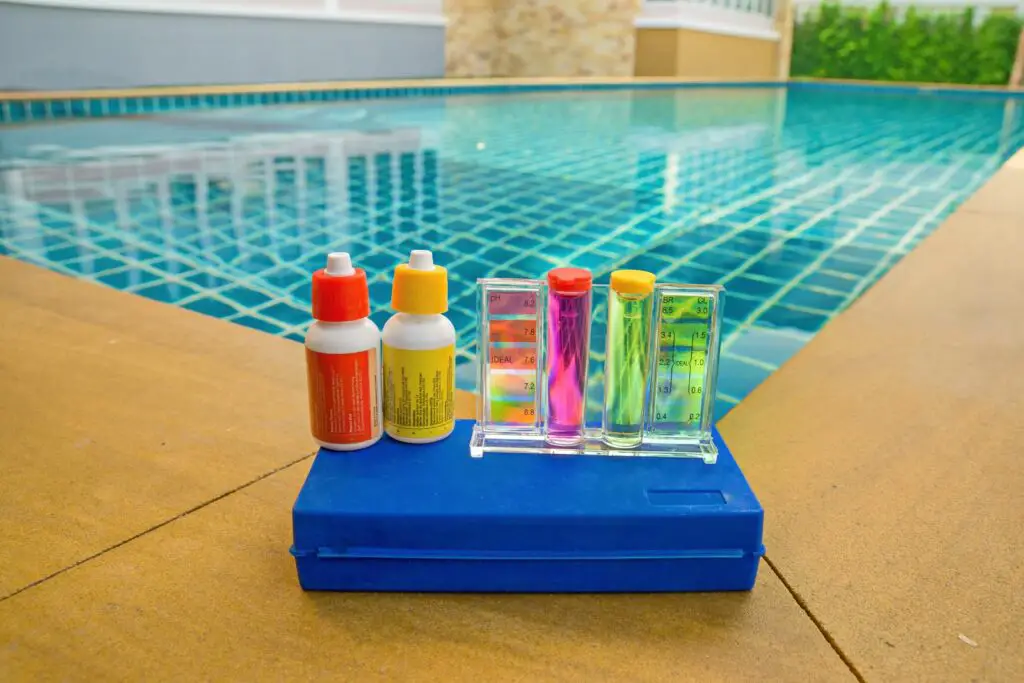
Want to learn more about algaecide? Read on to find out when to add algaecide to your pool maintenance routine and other helpful tips.
Chlorine is one of the most important chemicals you can put into your pool. Chlorine is what is known as a “sanitizer” in pool chemistry. This means that it is responsible for cleaning your pool water. This make sure it is safe and bacteria-free. This article will dive into the Suggested Free Chlorine level you test for. This includes explaining what Suggested Free Chlorine is, why it is important, and how it differentiates itself from your Free Chlorine level.
Click here to learn about the relationship between Free Chlorine and Total Chlorine
Suggested Free Chlorine can simply be put as the balance between your Free Chlorine level and the level of Cyanuric Acid in your pool water. Why is this important you may ask? While Cyanuric Acid serves as a buffer and protection for the Free Chlorine in your water, it also decreases the cleaning power of Chlorine. This means that as you add more Cyanuric Acid to your pool you will also need to add more Chlorine in order to reach the optimum level of Chlorine cleaning power. This is why Suggested Free Chlorine is important to test for.
To read an article on the relationship between Chlorine and Cyanuric Acid, click here!
Many people assume that your Free Chlorine level is all you need to base your chemical treatments on. And this may be true if you are not treating with Cyanuric Acid. However, most people nowadays treat their water with Cyanuric Acid in order to save money and preserve the Chlorine they have in their water. If you don’t use Cyanuric Acid, you will find yourself needing to treat with Chlorine more than normal. This is because UV rays do a great job breaking down Chlorine molecules. More Chlorine treatment equals to more money spent on chemical treatment. More treatment means more of an investment than is necessary in your pool.

Simply put, Suggested Free Chlorine is the amount of Free Chlorine you need in your pool in order to balance out the Cyanuric Acid level present in your water. This calculation is found in a very simple way. Pool Calculator takes your current Free Chlorine level and Cyanuric Acid level at face value. Then, it suggests a Free Chlorine level that will account for the Cyanuric Acid while still giving you a Chlorine level high enough to sanitize your pool.
Suggested Free Chlorine accounts for your Cyanuric Acid level, and Free Chlorine does not.
This is a question that is hard to answer in simple terms. Your Suggested Free Chlorine balance is all based on what level of Cyanuric Acid you have in your pool. Your Free Chlorine level is supposed to be in the range of 3 to 7 parts per million. This will not change no matter what your Cyanuric Acid level is in your pool water. However, the amount of Free Chlorine you need to add will change based on Cyanuric Acid in order to reach that goal. This is why Suggested Free Chlorine is so important to your pool’s balance and health as a whole.
Balance your pool water and try out the Suggested Free Chlorine measurement here!

Want to learn more about algaecide? Read on to find out when to add algaecide to your pool maintenance routine and other helpful tips.

In this quick guide, we’ll answer the question “can you over shock a pool” and unveil the factors to consider when shocking a pool.

Maintaining both pH and total alkalinity in your swimming pool is important for keeping your pool properly sanitized and non-corrosive. Total alkalinity is to pH what cyanuric acid is to free chlorine. Total alkalinity stabilizes pH levels. The ideal pool pH level is 7.4 to 7.6. The ideal total alkalinity level is 80 to 120 ppm.

The Association of Pool and Spa Professionals recommends free chlorine levels for both swimming pools and hot tubs be kept between 2.0 and 4.0 ppm. However, the Center for Disease Control recommends free chlorine stay above 1 ppm in pools and 3 ppm in hot tubs.